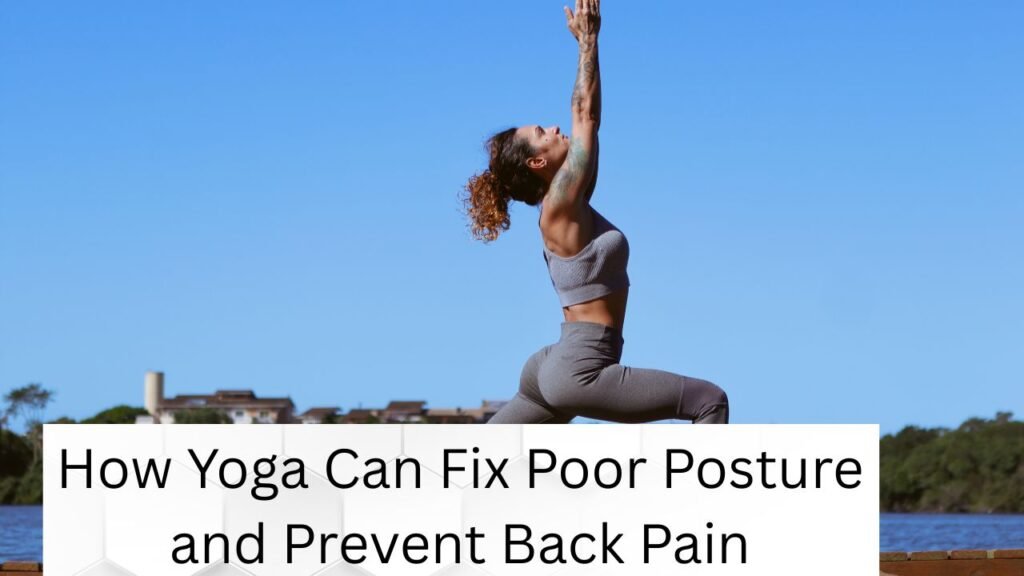Modern lifestyles encourage prolonged sitting, excessive screen time, and repetitive movements that take a toll on posture. Poor posture can lead to chronic back pain, stiffness, and misalignment. Yoga offers a natural and effective way to correct posture and prevent discomfort by strengthening muscles, improving flexibility, and promoting body awareness.

Understanding Poor Posture and Back Pain
Poor posture is more than just slouching; it involves structural imbalances that put strain on the spine and surrounding muscles. Common posture problems include:
- Forward head posture – caused by excessive screen use and weak neck muscles.
- Rounded shoulders – from prolonged desk work and poor sitting habits.
- Anterior pelvic tilt – due to tight hip flexors and weak core muscles.
- Kyphosis (hunchback posture) – caused by a weak upper back and tight chest muscles.
These postural issues contribute to chronic back pain, tension headaches, and reduced mobility. Yoga can help by restoring alignment, strengthening weak muscles, and releasing tight ones.
How Yoga Helps Correct Posture
Yoga works by targeting the muscles that support the spine and joints. A consistent yoga practice can:
- Strengthen Core Muscles
- The core stabilizes the spine and prevents excessive arching or slumping.
- Poses like Plank, Boat Pose, and Warrior III build core stability.
- Improve Spinal Alignment
- Yoga teaches awareness of spinal position and promotes proper alignment.
- Mountain Pose and Tadasana encourage a neutral spine.
- Increase Flexibility
- Tight muscles restrict movement and pull the body out of alignment.
- Downward Dog, Cat-Cow, and Seated Forward Fold enhance flexibility in the spine, hamstrings, and shoulders.
- Release Tension in Key Areas
- Yoga relieves tightness in the neck, shoulders, and lower back.
- Child’s Pose and Thread-the-Needle are excellent for releasing muscle knots.
- Enhance Body Awareness
- Mindful movement and breathwork improve posture by increasing awareness of body positioning.
- Practicing yoga regularly trains the body to maintain proper alignment naturally.
Best Yoga Poses for Posture Correction and Back Pain Prevention
1. Mountain Pose (Tadasana)
- Strengthens the core and aligns the spine.
- Stand tall with feet together, engage the thighs, and lengthen the spine.
2. Cat-Cow Stretch (Marjaryasana-Bitilasana)
- Improves spinal mobility and relieves tension in the back.
- Alternate between arching and rounding the spine while synchronizing breath.
3. Downward Facing Dog (Adho Mukha Svanasana)
- Stretches the hamstrings, shoulders, and spine.
- Helps counteract the effects of prolonged sitting.
4. Plank Pose
- Strengthens the core, shoulders, and back muscles.
- Hold the pose with a straight back and engaged core for proper spinal support.
5. Child’s Pose (Balasana)
- Releases lower back tension and relaxes the spine.
- Stretch arms forward and sit back onto heels for a deep stretch.
6. Cobra Pose (Bhujangasana)
- Strengthens the lower back and opens the chest.
- Keep elbows slightly bent and lift the chest while keeping hips grounded.
7. Bridge Pose (Setu Bandhasana)
- Engages the glutes and core, helping to reverse slouching.
- Lie on your back, press feet into the mat, and lift the hips.
8. Seated Forward Fold (Paschimottanasana)
- Stretches the hamstrings and lower back.
- Fold forward from the hips and keep the spine long.
9. Thread-the-Needle Stretch
- Relieves tension in the shoulders and upper back.
- Thread one arm under the body while resting on the opposite shoulder.
10. Wall Angels
- Corrects rounded shoulders and improves shoulder mobility.
- Stand with back against a wall and move arms in a controlled up-and-down motion.
Tips for Practicing Yoga for Posture Improvement
- Practice Daily: Consistency is key. Even 10–15 minutes daily can lead to noticeable improvements.
- Focus on Alignment: Perform each pose with proper form to avoid strain.
- Breathe Deeply: Conscious breathing enhances relaxation and helps release tension.
- Combine Strength and Flexibility: Balance strengthening poses with stretches for optimal posture correction.
- Use Props If Needed: Blocks and straps can assist in maintaining correct posture.
Final Thoughts
Yoga is a powerful tool for fixing poor posture and preventing back pain. By strengthening the core, improving flexibility, and enhancing awareness, yoga promotes long-term spinal health. A regular practice incorporating the right poses can correct postural imbalances, relieve tension, and restore natural alignment. Start incorporating these yoga poses today and experience the benefits of better posture and pain-free movement.